Webinar Marketing Fundamentals: Five Steps to Drive Registrations and Increase Attendees

Table of Contents
Maximize Your Marketing ROI
Join 10,000 other marketers already getting the best tips on running engaging events that boost pipeline and create raving fans.
Webinars: a marketer’s best friend and biggest foe.
While webinars can be extremely impactful for generating and nurturing leads (not to mention celebrating and elevating your community), they can also create major headaches from a marketing and engagement perspective.

Getting people to commit to more screen time during the day can be difficult. Getting them to actually show up is a feat by any definition.
Plus, most webinars are a dime a dozen—especially in the post-pandemic era where many companies have scaled their virtual marketing efforts.
In a world of cluttered inboxes and frenzied feeds, how can you get in front of the right audience to drive awareness for your event? And, how can you get folks to actually show up for your event?
You’ve got questions, we’ve got answers. 🙌🏼
In this post, we’ll outline a five-step webinar marketing roadmap to getting in front of the right audience and driving more attendees to your virtual events.
Here’s what we’ll cover:
- Select a relevant webinar topic and format
- Define and find your niche audience
- Promote your event early and often
- Make webinar registration a breeze
- Create a frictionless attendee experience
📈 Stay up to date with the latest trends in our B2B Webinar Benchmark Report
1) Select a relevant webinar topic and format
First things first, you have to nail down your webinar topic and event format. We know what you’re thinking, “It’s a webinar, we know what we’re doing!”
While creating a webinar used to follow a “set it and forget it” format—a one-hour long event, one speaker, slides, and Q&A—that’s simply not the case anymore. At least, it doesn’t have to be.
Think of your webinars as mini-virtual events. There’s no reason to limit yourself to the “standard” format. Why not mix it up? Try ditching the slides and hosting a lively fireside chat, multi-speaker panel, or friendly “debate” session instead.
If slides and visuals are important to your narrative, try other types of content like video clips, polls, and live video questions to keep your audience engaged.
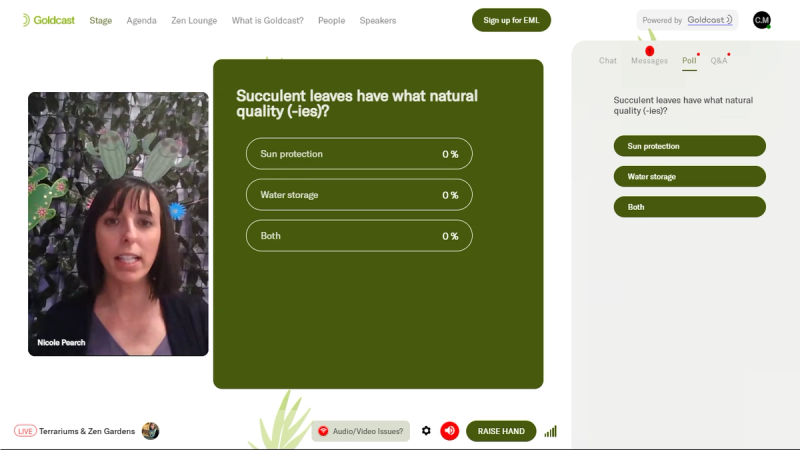
Your topic and webinar content are equally—if not more—important than the delivery method. Be sure to pick a topic that clearly aligns with the audience you’re targeting and an angle that is unique to what’s already in the market.
And remember—specific is better. Specifics and granularity can take otherwise generic content and instantly make it shine. Details paint pictures and create connections with the audience. When possible, use precise words and specific examples to support your story.
For example, what tells a better story?
- ROI > 55% improvement in webinar engagement after just one event
- Rock star presenter > More fun to watch than Freddie Mercury
- Dog > A fluffy miniature dachshund named Albus
… You get the point. Don’t go overboard or add fluff for the sake of details. But do get specific and tell a story with details to connect with your audience.
“Think of your webinars as mini-virtual events. There’s no reason to limit yourself to the ‘standard’ format.”
2) Define and find your niche audience
Alright, now that you’ve nailed down your webinar topic and your virtual event format, it’s time to focus on your audience.
Again, you’ll want to get granular. Instead of just “marketing managers,” think about specific personas or titles that will care about your topic. Understand how these folks operate, what their pain points are, and what language resonates with them.
For example, we recently hosted a webinar with our friends at Tray.io on using low code automation to scale events. Given how technical this topic is, we geared the content and targeting around folks in operations roles (marketing operations, sales operations, etc.)

Another recent webinar, The Great Debate: Post-Event Follow-Up, focused on post-event follow-up and who should own the outreach. Given the topic, we catered the content and promotion towards folks in revenue-generating marketing and sales roles (digital marketing managers, business development reps, etc.)
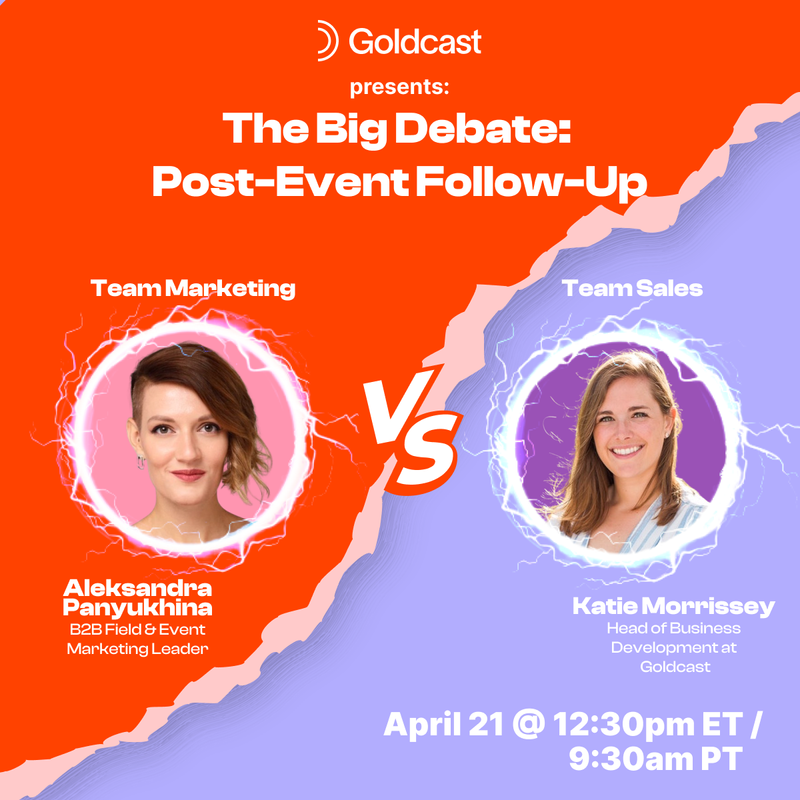
Once you define your niche audience, you’ll want to think about the best places to get in front of these folks. Where do they spend time online? How do they typically find content and events?
You’ll use this info in a bit when we talk about promo, so keep reading!
3) Promote your event early and often
Now for the fun part: webinar promotion!
Our biggest hot tip is in the headline—promote your event early and often.
It’s no secret that people have short attention spans. Inboxes and newsfeeds are crowded, so one simple post or send isn’t going to cut it.
Here are five places to promote your webinar:
Email is often the number one source for generating webinar registrations, which makes total sense! These folks are already familiar with your brand and are generally warm to hearing from you. Depending on your marketing mix, email can generate over 60% of the total attendees for your webinar.
“Depending on your marketing mix, email can generate over 60% of the total attendees for your webinar.”
Here are three ways you can use email to promote your webinar:
- Dedicated email lists: Do not just invite your entire database and hope for the best! Segment your marketing list according to the topic and audience for your event. Luckily, marketing automation platforms make this process pretty easy!
- Sales outreach: Keep your sales team in the loop on all upcoming events, and encourage them to invite relevant prospects to attend. Make it even easier by having promo copy and registration links ready to go.
- Email signature banners: A creative way to drive awareness for events? Create and share flashy banners that folks can easily pop into their email signatures. Be sure to include the link to the event in the image so that folks have a destination when they click.

The biggest takeaway here is to avoid blasting your entire database. Be intentional about your outreach, or run the risk of being marked as spam!
Of course, if you’re using webinars for lead generation, you’ll want to reach some new folks that aren’t in your database yet. We’ll cover that next!
🤳 Social Media
Social media can be another highly effective marketing channel for generating webinar buzz. The key to winning on social is to only focus on the most relevant platforms and go all-in on your promo.
Here are a few social spots where B2B marketers might want to promote events:
- LinkedIn: This platform is the best place to reach a warm B2B audience. Try creating an event on LinkedIn and sync this data with your CRM to streamline the registration process. And be sure to ask hosts and guests to share the event with their followers.
- Twitter: Another hot spot for niche marketing communities, try using relevant hashtags (like #MarketingTwitter) to reach these folks. Also, try live-tweeting your event to start conversations around your content.
- Facebook: Though Facebook is often preferred for personal use, the platform does serve as a hub for communities. Tap these communities to spread the word, and set up an event on your brand’s Facebook page to keep page followers in the loop.
- Instagram: A highly visual platform, Instagram can be a good place to repurpose video content or promo graphics. Take things to another level by having your host post a story about the event on your brand’s page.
📹 Hot tip: 85% of social media users want more videos from brands. Give the people what they want! Try having your webinar host create a personal video invite. This can be super simple—a “talking head” style recording introducing themselves, sharing info about the event, and inviting folks to join can work magic! Check out our example below 👇🏼
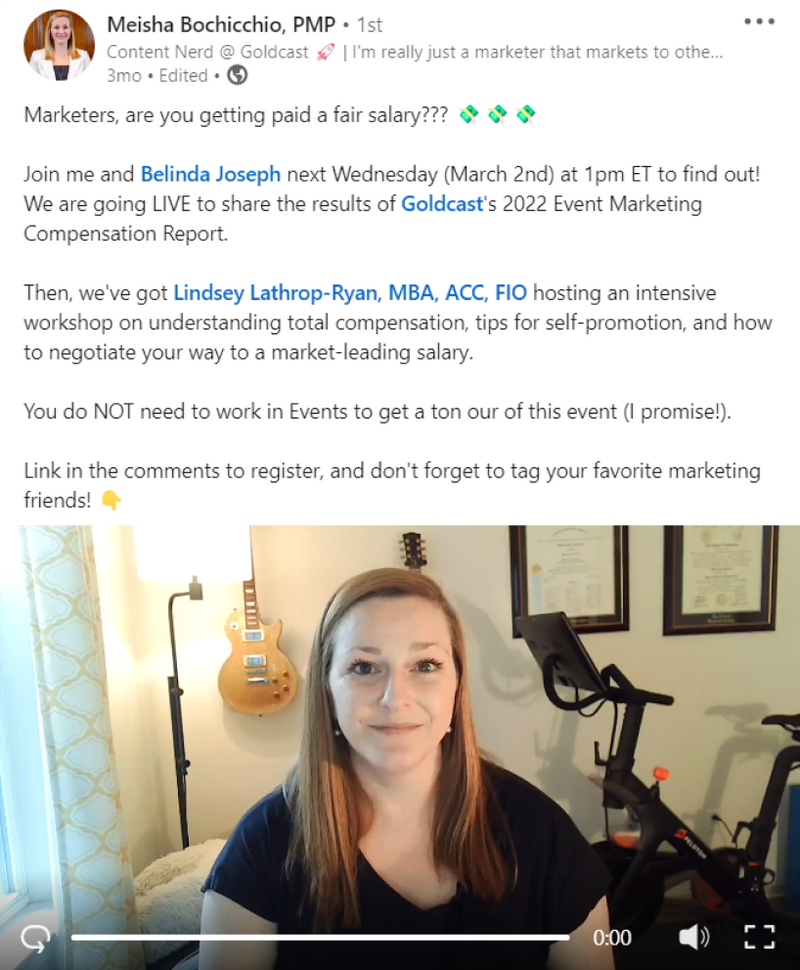
💻 Website banners and popups
Your website is prime real estate for promoting upcoming webinars. Folks visiting your website are there to learn more about your brand, product, or service. Take advantage of these warm eyes with strategic banners and popups.
Here are three ways to promote upcoming webinars across your website:
- Website banners: Banners are typically static images or “sticky” graphics that stand out from other webpage content. These should grab viewers’ attention without being intrusive. Check out Alyce’s homepage banner below.
- Popups or chatbots: Despite their reputation for being annoying, website popups and chatbots can be highly effective when used strategically. The key is not to bombard folks as soon as they land on your site and keep the copy and call-to-action hyper-relevant.
- Dedicated event page: If your website has a resource center, consider adding a dedicated page for all upcoming events. This will make it super easy for folks to find and register for upcoming webinars!

💸 Paid placements
Unfortunately, many platforms operate on a “pay to play” model, making it difficult to get traction organically. If you have the budget, try experimenting with paid promotions to drive webinar registrations. Be sure to monitor registrations to keep your cost per lead in check.
Here are three paid placements to try for webinars:
- Paid social: Social platforms offer many options for promoting content. Be sure you understand all of the different formats and placements in addition to the targeting parameters offered by each channel.
- Newsletter sponsorship: Newsletters are all the rage and can be a highly effective way to reach a new but relevant audience. Don’t be afraid to go niche here. You don’t have to target the Marketing Brews of the world, which have large audiences but charge a premium to reach them. Instead, look for smaller newsletters that are very relevant to your target audience.
- Community sponsorship: Another creative way to reach a niche audience is community sponsorship. Research groups relevant to your audience and see if they offer paid partnerships like inclusion in upcoming emails or slack promotions. See an example from Casted below.
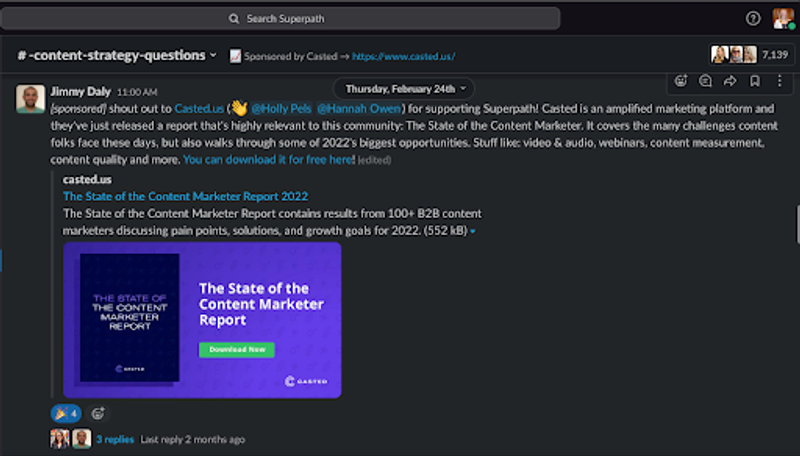
💰Hot tip: Be strategic with your advertising budget with retargeting campaigns. This way, you’re reaching folks who are already familiar with your brand or content. Retargeting can be used across display, search, and social media campaigns.
🤝🏼 Partner promotions
Last but certainly not least, ask your partners and other “friendlies” to spread the word within their networks. It’s as simple as asking.
For partners or event co-hosts, whip up a few assets and sample promo copy that they can easily use on their end.


4) Make webinar registration a breeze
Ok, you’ve got a promo plan in place. Awesome!
Now it’s time to shift gears a bit and focus on the webinar registration experience.
The data is a bit murky, but the average landing page conversion rate is only around 2% - 6%, which isn’t great. Of course, not everyone who lands on your webinar page is going to want to attend your event (as much as we wish that was the case!). However, there are things you can do to increase your chances of securing the bag (er, registration).
Simply put—make your registration process as simple as possible to increase your event registration conversion rate.
How can you make this process seamless?
First, be sure you have a prominent form or call-to-action that anchor links to a form. Folks are generally familiar with landing pages, so they know what to expect. Don’t interfere with this familiarity—this isn’t the place to get creative. Instead, stick to a straightforward webinar landing page with only the most relevant information: general topic information, speaker details, and a registration form. Peep this example from RevGenius—can’t miss that CTA!
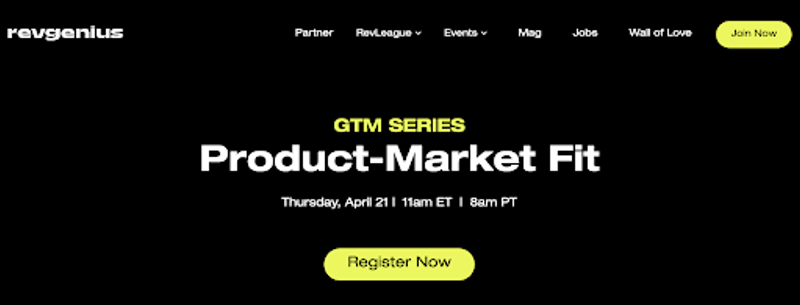
Then, be sure you’re only asking for essential information—name and email address. You can always capture more data later or fill in the details on the backend with data enrichment (via solutions like Clearbit). Prioritize getting more registrations over more data, always.
Finally, use a webinar solution that automatically sends registrants a calendar invite. This is a small but mighty way to be sure your event is on folks’ radars and to make showing up easier than ever.
Say goodbye to buried email invites and hello to calendar blocks and magic links! 👋🏼
5) Create a frictionless attendee experience
Speaking of automatic calendar invites, this is key to making sure your webinar registrants become webinar attendees. By blocking time on the calendar, you ensure your event is front and center and that nothing else accidentally gets booked during this time.
Reminder emails are also critical to keeping your webinar top of mind. You typically have two options for automated emails: Your webinar platform or your email/marketing automation platform.
Using your webinar provider for emails is convenient because you can easily add magic links and other event info without having to copy/paste the info into another platform. However, you might prefer to keep all marketing emails in one place. Whichever route you pick, be sure you schedule a few timely reminders before your webinar to keep the event top of mind.
Magic links are also essential to ensuring folks have a frictionless event experience. These aren’t your standard Zoom links. Instead, Magic Links grant access to an event without the use of a password or asking attendees to set up a profile in advance. Nifty!
If you have a webinar with multiple sessions or tracks, having a platform that automatically redirects folks to the next presentation is critical for preventing drop-off.
Webinar marketing “must-haves”
Whew, that was a lot! If you’ve made it this far, you’re well on your way to simplifying and scaling your webinar marketing strategy.
To simplify things a bit more, here’s a list of “must-have” assets and marketing tips:
- Webinar platform - Look for a webinar platform that offers all of the great attendee and organizer experience features mentioned above: Magic links, automated reminder emails, automatic calendar blocks, etc.
- Landing page for registrations - You’ll want a spiffy landing page for folks to register. As we covered above, keep these pages simple with info on the topic, speakers, and how to register.
- Registration form - Ideally, you’ll want forms that sync data between your event platform and your CRM. This will make reporting and lead generation effortless.
- Promo assets - What will you need to promote your event? Think about all of the social graphics, email images, video invites, etc., and submit those to design well in advance.
- Webinar assets - What will you need for the webinar? Think about things like slides, videos, poll questions, seed questions for Q&A, etc.
🔥 Hot tip: Many of these items can be templatized to save time in the future. If you’re using a project management tool, create a template that you can copy for all future webinars.
Monitor event registrants and attendance in real-time
Creating content that “wows” your audience and a full promo plan is just the beginning when it comes to how to market a webinar.
You’ll also want to monitor promotion analytics to see what’s working and what’s not. With the right tools in place, you can quickly pivot to pull back on tactics that aren’t working and double down on promotions that drive results.
Here are five places to keep data in check during your webinar marketing:
- Email marketing: As a top driver of webinar registrations, you’ll want to be sure your emails are reaching the right folks and driving engagement. Look at things like the open rate, click-rate, and click-through rate to see how folks are moving through your emails, and benchmark this data against other webinars to gauge success.
- Social media: Check-in on your social posts and promotions. Are folks engaging with your posts? Are any paid promotions getting clicks? Are dedicated event pages driving registrations? Don’t be afraid to re-allocate the budget or suspend future posts if social isn’t moving the needle.
- Webinar platform: With the right webinar platform, you’ll be able to see attendee information and other data all in one place.
- MAP and CRM: With the right tech stack, you’ll be able to seamlessly feed registration data into your marketing automation and customer relationship platforms. This unlocks so much power in transforming webinars into demand gen machines.
📈 Hot tip: Create a single source of truth for all webinar marketing data. This could be as simple as a shared spreadsheet or as robust as an analytics dashboard. Whatever your route, benchmarking this data over time will create more transparency and help teams measure the success of the webinar program.
Thanks for hanging in there with us!
If you enjoyed this post, just know that these webinar marketing tips are just the “tip” of the iceberg. 😉
Puns aside, we’ve got several more resources to help you transform webinars into top lead and revenue-generating events.
If you haven’t already, be sure to snag your free webinar marketing checklist (no gate, just download and enjoy!), and peep our post below on repurposing your webinar content across multiple different formats and channels.

Stay In Touch
Platform
Resources
Company
Community
© 2024 Copyright Goldcast, Inc. All rights reserved.